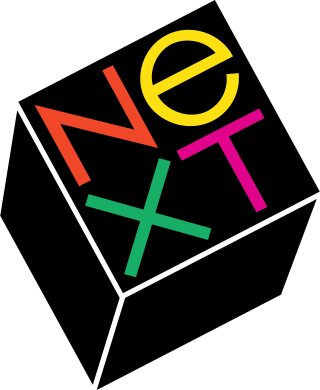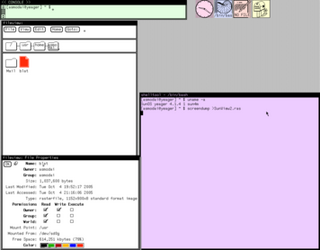
The Common Desktop Environment (CDE) is a desktop environment for Unix and OpenVMS, based on the Motif widget toolkit. It was part of the UNIX 98 Workstation Product Standard, and was for a long time the Unix desktop associated with commercial Unix workstations. It helped to influence early implementations of successor projects such as KDE and GNOME, which largely replaced CDE following the turn of the century.

The history of the graphical user interface, understood as the use of graphic icons and a pointing device to control a computer, covers a five-decade span of incremental refinements, built on some constant core principles. Several vendors have created their own windowing systems based on independent code, but with basic elements in common that define the WIMP "window, icon, menu and pointing device" paradigm.
SunOS is a Unix-branded operating system developed by Sun Microsystems for their workstation and server computer systems. The SunOS name is usually only used to refer to versions 1.0 to 4.1.4, which were based on BSD, while versions 5.0 and later are based on UNIX System V Release 4 and are marketed under the brand name Solaris.

The X Window System is a windowing system for bitmap displays, common on Unix-like operating systems.

Solaris is a proprietary Unix operating system originally developed by Sun Microsystems. After the Sun acquisition by Oracle in 2010, it was renamed Oracle Solaris.

OpenStep is an object-oriented application programming interface (API) specification that was developed by NeXT Computer. It provides a framework for building graphical user interfaces (GUIs) and developing software applications. OpenStep was designed to be platform-independent, allowing developers to write code that could run on multiple operating systems, including NeXTSTEP, Windows NT, and various Unix-based systems. It has influenced the development of other GUI frameworks, such as Cocoa for macOS and GNUstep.

NeWS is a discontinued windowing system developed by Sun Microsystems in the mid-1980s. Originally known as "SunDew", its primary authors were James Gosling and David S. H. Rosenthal. The NeWS interpreter was based on PostScript extending it to allow interaction and multiple "contexts" to support windows. Like PostScript, NeWS could be used as a complete programming language, but unlike PostScript, NeWS could be used to make complete interactive programs with mouse support and a GUI.
In computing, a desktop environment (DE) is an implementation of the desktop metaphor made of a bundle of programs running on top of a computer operating system that share a common graphical user interface (GUI), sometimes described as a graphical shell. The desktop environment was seen mostly on personal computers until the rise of mobile computing. Desktop GUIs help the user to easily access and edit files, while they usually do not provide access to all of the features found in the underlying operating system. Instead, the traditional command-line interface (CLI) is still used when full control over the operating system is required.

In computing, a windowing system is a software suite that manages separately different parts of display screens. It is a type of graphical user interface (GUI) which implements the WIMP paradigm for a user interface.

OPEN LOOK is a graphical user interface (GUI) specification for UNIX workstations. It was originally defined in the late 1980s by Sun Microsystems and AT&T Corporation.
Distributed Objects Everywhere (DOE) was a long-running Sun Microsystems project to build a distributed computing environment based on the CORBA system in the 'back end' and OpenStep as the user interface. First started in 1990 and announced soon thereafter, it remained vaporware for many years before it was finally released as NEO in 1995. It was sold for only a short period before being dropped in 1996. In its place is what is today known as Enterprise JavaBeans.
NX technology, commonly known as NX or NoMachine, is a remote access and remote control computer software, allowing remote desktop access and maintenance of computers. It is developed by the Luxembourg-based company NoMachine S.à r.l.. NoMachine is proprietary software and is free-of-charge for non-commercial use.
In computing, the X Window System is a network-transparent windowing system for bitmap displays. This article details the protocols and technical structure of X11.

SunView is a discontinued user interface toolkit and windowing system from Sun Microsystems, launched in 1985, and included as part of its Unix implementation, starting with SunOS Release 3.0. Sun had introduced support in 1983 for a window-based environment known as the Sun Window System, providing the Sunwindows window manager and Suntools user interface toolkit.
Xsun is an X Window System (X11) display server implementation included with Solaris, developed by Sun Microsystems. It replaced the older Xnews server, which supported the display of not only X11 applications, but also NeWS and SunView programs. Xsun discontinued support for these legacy environments, and added support for Display PostScript.
VirtualGL is an open-source software package that redirects the 3D rendering commands from Unix and Linux OpenGL applications to 3D accelerator hardware in a dedicated server and sends the rendered output to a (thin) client located elsewhere on the network. On the server side, VirtualGL consists of a library that handles the redirection and a wrapper program that instructs applications to use this library. Clients can connect to the server either using a remote X11 connection or using an X11 proxy such as a VNC server. In case of an X11 connection some client-side VirtualGL software is also needed to receive the rendered graphics output separately from the X11 stream. In case of a VNC connection no specific client-side software is needed other than the VNC client itself.

olwm was the default stacking window manager for OpenWindows, the original X11 desktop environment included with SunOS and Solaris. Its unique characteristic is its implementation of the OPEN LOOK look and feel.
Adaptive Internet Protocol (AIP) is a multi-channel protocol that allows an application running on any of multiple platforms to be displayed on any of a wide range of client systems. It supports rich remote display and input services with a number of display options to deliver the presentation of the remote applications onto the local display either as a standalone window, or within a contained remote environment delivered full-screen or in a standalone window. The protocol also supports audio, printing, and other device mapping services.
OLIT is a widget toolkit from Sun Microsystems introduced in 1988, providing an OPEN LOOK user interface for X Window System applications. It provides an Xt application programming interface for the C programming language, providing an easy way for those familiar with Xt programming to implement the OPEN LOOK look and feel.










